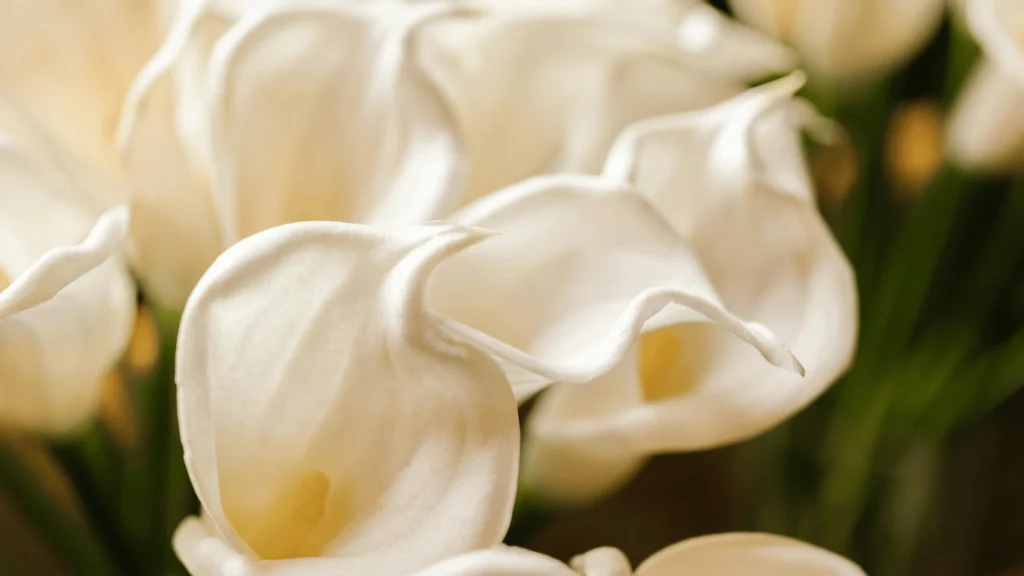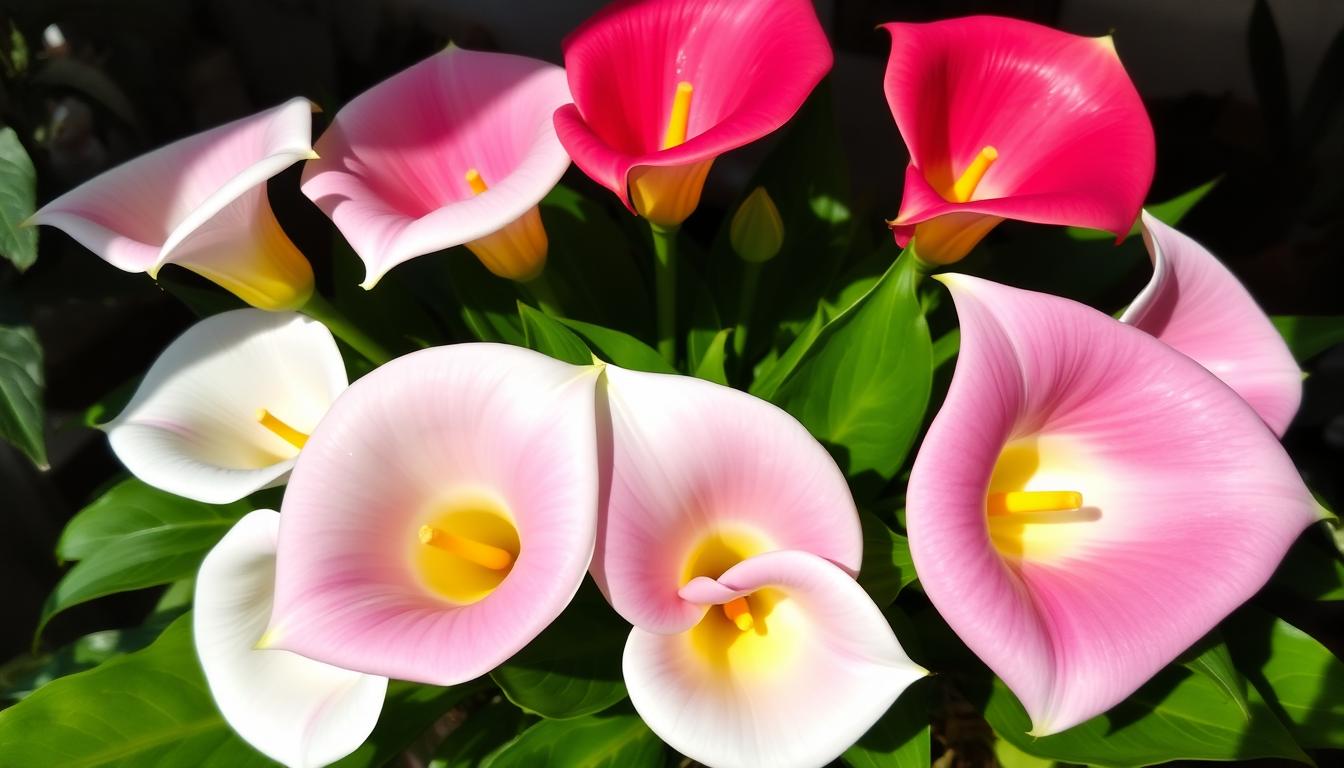As winter ends, the idea of growing a calla lily indoors excites us. This tropical flower can turn any room into a peaceful oasis. It brings a touch of nature’s beauty, even when it’s cold outside.
Whether you’re new to gardening or have experience, growing a calla lily indoors is rewarding. With the right care and dedication, you can enjoy its beauty in your home for weeks.
Table of Contents
Understanding Calla Lily: A Sophisticated Indoor Beauty
Calla lilies are a stunning addition to any indoor garden. They come from southern Africa’s wetlands. Today, there are many varieties, each with its own beauty.
Origins and Natural Habitat
The calla lily, or Zantedeschia, grows in southern Africa’s marshy areas. They love moist, well-drained soil near water. This environment helps them grow lush and bloom beautifully.
Different Calla Lily Varieties and Colors
- The classic calla lily flower has striking, trumpet-shaped blooms in white, yellow, pink, and purple.
- Dark calla lily varieties have almost black flowers, adding a dramatic touch.
- Some calla lily plants have spotted or ruffled petals, making them visually interesting.
Growth Characteristics
Calla lilies are low-growing plants with tall stalks and large leaves. They can grow from 12 to 36 inches tall. This makes them perfect for many indoor spaces.
“Calla lilies are a symbol of beauty, purity, and magnificent splendor.”
Essential Requirements for Indoor Calla Lily Growth
Growing calla lilies indoors needs careful attention to certain factors. This ensures they grow well and bloom brightly. Whether you’re new to gardening or have experience, knowing what your calla lilies need is crucial for beautiful results.
One key thing for indoor calla lilies is enough light. They do best in bright, indirect sunlight. Place them near a window that faces south or west. But, don’t let them get direct sunlight, as it can burn their leaves and flowers.
- Give them at least 6 hours of bright, indirect light each day for the best growth.
- If it’s too dark, use artificial grow lights to help, especially in winter.
Keeping the right temperature is also important. Calla lilies like daytime temperatures between 65-75°F (18-24°C). At night, they prefer it a bit cooler, between 55-65°F (13-18°C). Keeping this temperature helps them stay healthy and bloom well.
“Calla lilies are a versatile and elegant choice for indoor gardens, offering a touch of sophistication to any space.”
Calla lilies also need a humid environment to thrive. Try to keep the humidity at 50-60%. You can use a humidifier, put the plant on a pebble tray, or mist it regularly.
By focusing on these key needs for calla lily indoor care, you can make a great home for your plants. They will grow well and add beauty to your indoor space.
Ideal Light and Temperature Conditions
Getting the right light and temperature is key for your indoor calla lily plant to grow well. Knowing what light and temperature it needs in different seasons helps it thrive. This way, your calla lily can bloom beautifully.
Light Requirements Throughout Seasons
Calla lilies love bright, indirect sunlight. In spring and summer, put your plant in a spot with 6-8 hours of this light daily. As seasons change, move the plant to keep it in the best light spot. In fall and winter, use artificial light to keep it bright.
Temperature Management Tips
Calla lilies do best in temperatures between 65-75°F (18-24°C). Don’t let your plant get too hot or cold, as this can harm it. In hot months, keep it cool and well-ventilated. In cooler months, make sure it’s not too cold, below 60°F (15°C).
Humidity Control Methods
- Mist the leaves of your calla lily plant regularly to maintain optimal humidity levels.
- Consider using a pebble tray or placing the pot on a humidity tray filled with water to increase the surrounding humidity.
- If the air in your home is particularly dry, consider using a humidifier near your calla lily plant to boost the moisture content.
By giving your indoor calla lily the right light, temperature, and humidity, it will grow well. It will also bloom beautifully and last a long time.
Soil Selection and Potting Guidelines
Growing calla lily plants indoors requires the right soil and potting techniques. These plants do well in soil that drains well and is rich in nutrients. This soil mix should balance moisture and air for their roots.
To make the perfect soil mix, mix high-quality potting soil, perlite, and compost. This mix gives your calla lily the nutrients it needs and ensures good drainage. Make sure the pot has lots of holes for water to drain out.
- Use a well-draining potting mix made for calla lily plants.
- Add perlite or sand to improve soil aeration and drainage.
- Include compost or organic matter for essential nutrients.
- Choose a pot with lots of drainage holes to avoid root rot.
- Make sure the pot is the right size for your calalily plant.
“The key to thriving calla lily plants is providing the right soil conditions and potting environment for their roots to flourish.”
By following these guidelines, you’ll set up your calla lily plants for success. They will grow into beautiful, vibrant blooms that will brighten any room.

Watering and Fertilizing Best Practices
Proper watering and fertilizing are key for your indoor calla lilies to grow well and bloom brightly. Knowing the right watering schedule and when to fertilize can greatly help your calla lily thrive.
Proper Watering Schedule
Calla lilies need moderate water, with soil that’s consistently moist but not too wet. Water your calla lily when the top inch of soil feels dry, usually once or twice a week. Make sure to water deeply until the water drains from the pot’s bottom. Don’t let the soil dry out completely, as this can harm the plant and slow its growth.
Fertilizer Types and Application
To help your calla lily care and calla lily growth, use a balanced, water-soluble fertilizer made for flowering plants. Follow the manufacturer’s instructions, usually fertilizing every two to four weeks when the plant is actively growing. Don’t over-fertilize, as it can make the leaves grow too much at the expense of flowers.
Common Watering Mistakes to Avoid
- Letting the soil become completely dry before watering
- Allowing the plant to sit in standing water for prolonged periods
- Failing to adjust watering frequency based on seasonal changes and growth stages
By following these calla lily care tips for watering and fertilizing, you can enjoy the beautiful, long-lasting blooms that make this indoor plant a joy to have.
Managing Pests and Diseases
Keeping your calla lily plants healthy is more than just the right growing conditions. You must also watch out for pests and diseases. These can harm the beauty and health of your indoor calla lilies. By knowing common problems and acting early, you can keep your plants safe and enjoy their beauty for years.
Identifying and Tackling Pests
Spider mites, aphids, and thrips often attack calla lily plants. Look for webbing, discolored leaves, or tiny insects on leaves. To fight them, try introducing natural predators or use insecticidal soaps or neem oil. Always follow the instructions carefully.
Preventing and Treating Diseases
Calla lilies can get diseases like bacterial and fungal infections. Watch for yellow leaves, wilting, or spots. Good air circulation, avoiding overwatering, and using sterilized tools can help prevent diseases. If a disease appears, use organic fungicides or antifungal sprays on the affected areas.

“Proactive pest and disease management is key to keeping your indoor calla lily plants thriving and healthy.”
Prevention is better than cure for pests and diseases. Regularly check your plants, address problems quickly, and keep growing conditions good. This way, your indoor calla lily garden will stay beautiful and lively.
Pruning and Maintenance Tips
To keep your calla lily flowers looking great, you need to care for them seasonally and prune them. These easy tips will help your calla lilies bloom beautifully every year.
Deadheading Techniques
Deadheading is key to keeping your calla lilies blooming. When the flowers start to wilt, cut them off with clean, sharp pruners. Cut just above the leaves. This makes the plant focus on growing new flowers instead of seeds.
Seasonal Care Requirements
Calla lilies need different care at different times. In spring and summer, keep the soil moist but not too wet. In fall, cut back on watering to let the leaves die off naturally. In winter, keep the rhizomes cool and dry until spring.
Post-Blooming Care
After the flowers fade, your calla lily needs special care. When the leaves turn yellow and die, remove them carefully. This helps the plant save energy for next year’s blooms.
“Proper pruning and maintenance are key to enjoying the long-lasting beauty of calla lilies indoors.”
By following these tips, your calla lilies will stay healthy and bloom year after year. They’ll add elegance to your home.
Propagation Methods and Rhizome Division
Calla lilies are perennial plants that can be grown for years with rhizome division. This method lets you multiply your collection and keep your indoor garden full of color. It’s a simple way to ensure your calla lilies bloom continuously.
To grow more calla lilies, focus on the rhizome, the plant’s underground stem. These calla lily rhizomes are key for new growth. They can be divided to make more plants.
Dividing Calla Lily Rhizomes
- Carefully dig up the calla lily plant, exposing the rhizome.
- Examine the rhizome and locate the natural divisions or growth points.
- Use a clean, sharp knife to carefully divide the rhizome, ensuring each division has at least one eye or growth bud.
- Replant the divided rhizome sections in well-draining soil, spacing them about 12 inches apart.
- Water the newly planted rhizomes thoroughly and maintain consistent moisture until new growth appears.
With the right care, these calla lily rhizomes will grow into full plants. This shows how calla lilies are truly perennial. By dividing your calla lilies, you can enjoy their beauty year after year. Your indoor garden will stay vibrant and sustainable.
“Calla lilies are a timeless classic, and their ability to be propagated through rhizome division makes them a gardener’s delight.”
Conclusion
Growing calla lilies indoors can be very rewarding. By knowing what they need, you can enjoy vibrant blooms at home. These plants add elegance to any room.
Choosing the right soil and potting conditions is key. Also, make sure they get the right light and temperature. Keep an eye out for pests and diseases. Prune and maintain your plants to keep them blooming.
With a little care, you can enjoy calla lilies at home. They bring beauty and charm into your life. Start your journey in growing calla lilies indoors and watch them thrive.

